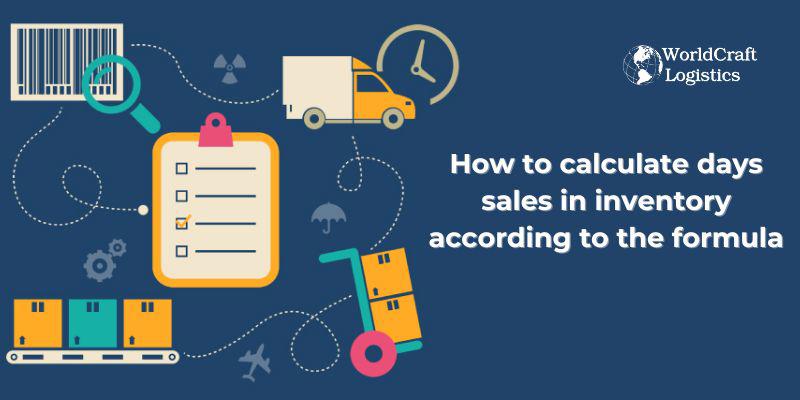
Starting June 1st, 2023 Our warehouse fee will be $0.65/cubic foot per month
In effort to lower the warehouse storage fee during inflation, we have went narrow aisle racking.This construction took us four months but the project is finally completed. With narrow aisle racking, we are able to drop storage by 24%.We as partners will go through this inflation together.
05/27/2024
The article will provided offers valuable insights into the importance of Days Sales in Inventory (DSI) for ecommerce businesses and how it impacts their operations and profitability.
Here's a breakdown of the key points covered:
Definition of Days Sales in Inventory (DSI)
Calculation of Average Days to Sell Inventory
Importance of Tracking DSI
Significance of Optimizing DSI
Additional Metrics for Comprehensive Inventory Management

Overall, the article underscores the importance of DSI in optimizing inventory management practices for ecommerce businesses and highlights the significance of monitoring this metric alongside other relevant indicators to drive operational efficiency and profitability.
Days Sales in Inventory abbreviated as DSI, also known as days sales of inventory, inventory days on hand, or days inventory outstanding, is a financial metric that provides insight into how efficiently a business is converting its inventory into sales. It measures the average number of days it takes for a company to sell its entire inventory.
DSI serves as a speedometer for inventory management, indicating whether products are moving quickly or remaining stagnant on shelves. By understanding DSI, businesses can:
✍️ Optimize Inventory Levels: DSI helps in finding the right balance between overstocking and understocking. Overstocking ties up capital in inventory, while understocking leads to lost sales opportunities.
✍️ Identify Problem Areas: High DSI can highlight slow-moving products that are occupying valuable warehouse space. Identifying these products allows businesses to adjust their strategies, such as offering promotions or discontinuing items.
✍️ Analyze Cash Flow: A high DSI can negatively impact cash flow, as excess inventory ties up capital that could be invested elsewhere. By reducing DSI, businesses can free up cash for growth initiatives, new product development, or responding to market changes.
Overall, DSI is a critical metric for inventory management, enabling businesses to optimize operations, improve cash flow, and identify areas for improvement.

Read more articles below:
👉 Finished Goods Inventory: How to Manage & Compute using formulas
👉 Control inventory health with great TIPS and specific indicators
👉 Inventory Forecasting: Definition, types, best practices & benefits
To calculate days sales in inventory (DSI), you can follow these steps:
Find the Average Inventory Value by adding the beginning and ending inventory values for a specific period, then divide the sum by two.
Average Inventory Value = (Beginning Inventory Value + Ending Inventory Value) / 2
Calculate the Cost of Goods Sold (COGS) by determining the total direct costs linked to producing or acquiring the goods sold within the same period.
Then, utilize the following formula to compute the Days Sales of Inventory (DSI):
DSI = (Average Inventory Value / Cost of Goods Sold) * 365
This formula reveals the average number of days your business takes to sell its entire inventory.
For instance, with the provided figures:
Average Inventory Value: $200,000
Cost of Goods Sold (COGS): $700,000
Substituting these values:
DSI = ($200,000 / $700,000) * 365
= 0.28 * 365 = 102.2 days
This indicates that, on average, your business requires approximately 102.2 days to sell its entire inventory.
By monitoring DSI over time and contrasting it with industry standards, you can gauge the effectiveness of your inventory management and pinpoint areas for enhancement.

Indeed, the average Days Sales in Inventory (DSI) can vary significantly across industries due to differences in demand patterns, product lifecycles, and inventory management practices. Here are some industry examples with typical DSI ranges:
Like groceries, toiletries, and household items, DSIs tend to be relatively low. This is because these products have high demand and fast turnover rates. A typical DSI for retail FMCG might range from 10 to 30 days.
Luxury goods such as high-end apparel, jewelry, and electronics often have longer sales cycles and lower turnover rates compared to FMCG. As a result, DSIs in the luxury goods sector are generally higher. For luxury items, a DSI of 60 to 120 days or more might be common due to the lower frequency of sales and higher price points.
In the automotive industry, where products like cars and trucks have longer sales cycles and higher price points, DSIs can be relatively high. Depending on the specific segment within the automotive industry (e.g., new cars, used cars), DSIs may range from 30 to 90 days or more.

👉 Read more: Car Export Service From USA With Cheapest Cost & Safety
The technology sector, including electronics and gadgets, often experiences rapid product obsolescence and evolving consumer preferences, leading to moderate to high DSIs. Depending on the type of technology product and market conditions, DSIs in this industry can range from 30 to 90 days.
In the food and beverage industry, DSIs can vary widely depending on factors such as perishability, seasonality, and distribution channels. Perishable goods like fresh produce may have lower DSIs (e.g., 10 to 20 days), while non-perishable items may have slightly higher DSIs (e.g., 20 to 40 days).
It's important for businesses to benchmark their DSI against industry averages to assess their inventory management performance accurately. However, it's crucial to consider other factors such as business model, market dynamics, and supply chain efficiency when interpreting DSI figures.

Interpreting your DSI involves assessing how efficiently your business is managing its inventory turnover. Here's how you can interpret your DSI:
Compare your DSI with industry averages or benchmarks to gauge your performance relative to competitors or similar businesses. If your DSI is significantly higher or lower than industry norms, it could indicate areas where you excel or need improvement.
Track changes in your DSI over time to identify trends and patterns. A decreasing DSI may indicate improved inventory management efficiency, faster turnover, and healthier cash flow. Conversely, an increasing DSI may signal inventory management challenges, slower sales, or overstocking issues.
Consider external factors and internal circumstances that may influence your DSI. Factors such as seasonality, market trends, promotional activities, supply chain disruptions, or changes in consumer behavior can impact inventory turnover and DSI. Analyze how these factors may be contributing to fluctuations in your DSI.
Assess the implications of your DSI on cash flow management. A lower DSI suggests that inventory is moving quickly, potentially freeing up cash for investment in growth initiatives or reducing financial strain. Conversely, a higher DSI may tie up capital in excess inventory, leading to cash flow challenges.
Evaluate how your DSI aligns with your operational goals and objectives. A well-managed DSI reflects efficient inventory control, accurate demand forecasting, effective procurement strategies, and streamlined operations. Identify areas for improvement based on your DSI analysis to optimize inventory management processes.
Consider DSI in conjunction with other financial and operational metrics, such as inventory turnover ratio, days inventory outstanding, and gross margin. These complementary metrics provide a more comprehensive view of inventory performance and help identify root causes of inventory management issues.

Understanding the limitations of Days Sales in Inventory (DSI) is important for making smart decisions about inventory. Here are some key points to consider:
Seasonality: DSI can change based on the time of year when demand goes up or down. Tracking DSI regularly helps spot trends beyond short-term changes and improves inventory management.
Demand Changes: Unexpected shifts in customer preferences or market trends can affect DSI. Keeping a close eye on DSI helps businesses react quickly to avoid running out of stock or having too much inventory.
New Products: DSI might not give accurate results for new products that haven't settled into stable sales patterns yet. It takes time to gather enough data to see how well new products are selling.
Industry Comparisons: While DSI is useful for comparing performance within the same industry, it may not be helpful for comparing between industries with different characteristics. It's essential to use industry-specific benchmarks for meaningful comparisons.
Data Quality: Accurate data is crucial for calculating DSI correctly. Mistakes in data collection or reporting can affect the reliability of DSI metrics. Also, remember to consider other factors like market conditions and business goals when interpreting DSI values.
By understanding these limitations, businesses can use DSI more effectively to improve inventory management and evaluate performance.
Whether you're a small business owner or a large company, these strategies can help you manage your inventory and improve your cash flow.
Predict demand: Analyze past sales data and external factors to forecast future demand accurately.
Monitor additional metrics: Besides Days Sales of Inventory (DSI), keep an eye on metrics like inventory turnover ratio, stockout rate, and inventory accuracy.
Prevent stockouts and overstocking: Set reorder points, maintain safety stock, and consider using inventory management software.
Use promotions wisely: Offer discounts or bundles strategically to move slow-moving inventory without damaging your brand.
Collaborate with suppliers: Communicate openly, negotiate favorable terms, and explore dropshipping options to reduce inventory holding costs.
Implement lean inventory management: Embrace "just-in-time" principles, eliminate waste, and focus on tracking key metrics to optimize efficiency.

Engaging with a third-party logistics (3PL) provider can significantly contribute to optimizing your Days Sales of Inventory (DSI) by streamlining your inventory processes.
3PLs assist in striking the optimal balance between maintaining adequate stock levels and avoiding overstock situations. Additionally, they help manage unforeseen fluctuations in sales, directly influencing inventory levels.
Leveraging sophisticated inventory management systems, 3PLs facilitate the optimization of inventory levels. These systems analyze demand patterns, monitor stock levels, and recommend suitable reorder points, thereby reducing surplus inventory and preventing stockouts.
While manual tracking using DSI formulas is beneficial, partnering with a proficient 3PL grants access to advanced analytics. This enables efficient monitoring of inventory ratios, ensuring optimal stock levels without excess.
Many 3PL companies offer advanced technology solutions, including Warehouse Management Systems (WMS), Transportation Management Systems (TMS), and inventory tracking software. These solutions provide real-time visibility into sales trends, stock levels, and DSI calculations, thereby enhancing forecasting accuracy and decision-making.
3PLs typically possess extensive networks of warehouses and distribution centers strategically positioned to minimize transit times and reduce carrying costs. Leveraging a distributed warehouse network enables positioning client inventory closer to customers, resulting in shorter shipping times, faster inventory turnover, and a reduced DSI.
👉 Read more: TOP 10 largest 3PL companies with good service in the US
In conclusion, Worldcraft Logistics believes that the concept of "Days Sales of Inventory" (DSI) serves as an important measure in evaluating the effectiveness of inventory management in a business. By understanding how quickly inventory is converted to revenue, organizations can streamline operations, optimize cash flow, and identify opportunities for improvement. Tracking DSI over time provides valuable insights into trends and performance, allowing businesses to make informed decisions and stay competitive in today's dynamic marketplace. Therefore, considering DSI as a key performance indicator will help businesses improve operational efficiency, meet customer needs effectively and ultimately drive sustainable growth and success.
SEO
Digital Marketing/SEO Specialist
Simon Mang is an SEO and Digital Marketing expert at Wordcraft Logistics. With many years of experience in the field of digital marketing, he has shaped and built strategies to effectively promote Wordcraft Logistics' online presence. With a deep understanding of the logistics industry, I have shared more than 500 specialized articles on many different topics.

Education
01/05/2025

Education
02/18/2025

Education
01/01/2024

Education
08/28/2024

Education
11/13/2023